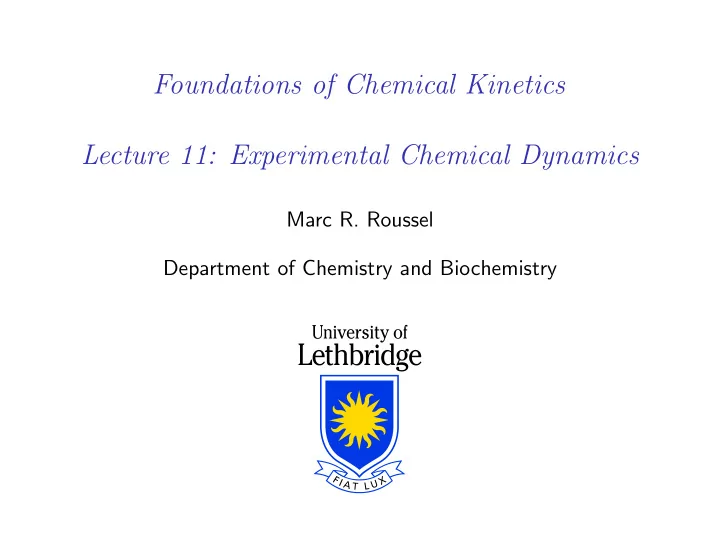

Foundations of Chemical Kinetics Lecture 11: Experimental Chemical Dynamics Marc R. Roussel Department of Chemistry and Biochemistry
Experimental chemical dynamics—Why? ◮ The fundamental problem of chemistry is controlling what happens when we mix A and B in order to get a desired product C. ◮ In many cases, there is kinetic competition between different reaction pathways. ◮ Conventional chemical kinetics provides only crude information on what is happening during a reaction and therefore why a particular product distribution is obtained. ◮ Experimental chemical dynamics seeks to probe reactions on an elementary level in order to extract detailed information.
The basic experiment of chemical dynamics: Crossed molecular beams B movable collimator detector θ A
Making a molecular beam ◮ Boil sample and heat gas to temperature T , then let it escape through a pinhole. ◮ Allow high-pressure gas to escape through a nozzle. ◮ Adiabatic expansion through the nozzle makes a cold gas. ◮ The beam can be velocity selected using a pair of rotating disks. reactant beam d ◮ Using lasers, the products can be excited to any desired quantum state prior to reaction.
Some detection methods Mass spectrometry used for product identification Time of flight measurement used for speed measurement scattered detector product d
Some detection methods (continued) Spectroscopy gives information on quantum state of product Infrared chemiluminescence: Vibrationally excited products emit infrared photons as they relax to their ground vibrational state. The spectrum of this emission is analyzed to yield the distribution of quantum states of the product. Laser induced fluorescence: A laser is tuned to a gap between two energy levels. The intensity of the subsequent fluorescence emission is proportional to the population of the initial state chosen, so again we get information on the distribution of quantum states of the product.
Data and insights obtained from molecular beam experiments ◮ Rate of product formation as a function of/resolved by ◮ Reactant relative velocity ◮ Reactant quantum state ◮ Scattering angles ◮ Product speed ◮ Product quantum state ◮ Depending on the experiment, we may have enough data to define the differential state-to-state cross-section. ◮ We get insight into where the energy goes after the products have been formed (rotation? vibration?) which in turn tells us something about the possible fate of those products in a more complex environment.
Recommend
More recommend